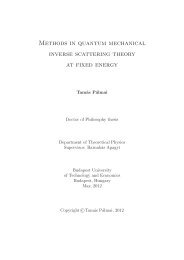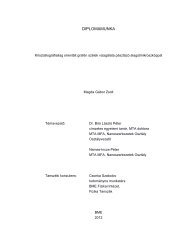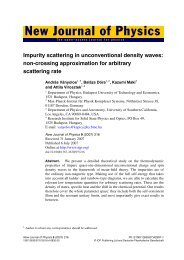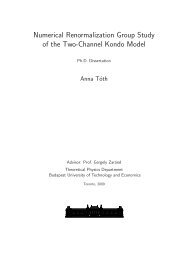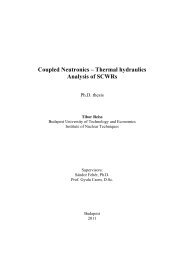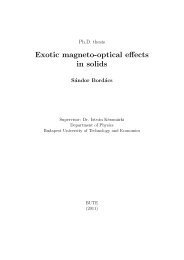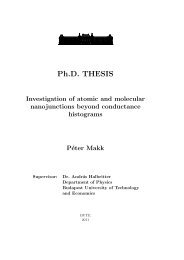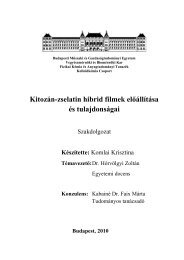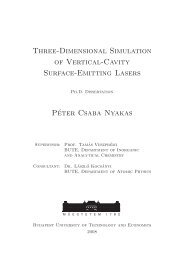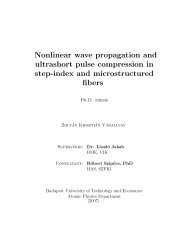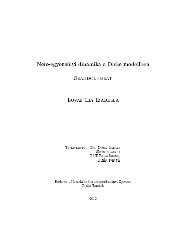Ph.D. THESIS Multipolar ordering in f-electron systems
Ph.D. THESIS Multipolar ordering in f-electron systems
Ph.D. THESIS Multipolar ordering in f-electron systems
Create successful ePaper yourself
Turn your PDF publications into a flip-book with our unique Google optimized e-Paper software.
Chapter 2 Overview of the Theoretical Background 17<br />
parameters act<strong>in</strong>g on the doublet (2.15) are<br />
|Γ + 3 〉〈Γ + 3 | − |Γ − 3 〉〈Γ − 3 | ∼ O 0 2 (2.20)<br />
|Γ + 3 〉〈Γ − 3 | + |Γ − 3 〉〈Γ + 3 | ∼ O 2 2 (2.21)<br />
i [ |Γ − 3 〉〈Γ + 3 | − |Γ + 3 〉〈Γ − 3 | ] ∼ T xyz . (2.22)<br />
By constructions, O2 0 and O2 2 are real operators, i.e., they are time reversal<br />
<strong>in</strong>variant, while T xyz is an imag<strong>in</strong>ary operator, i.e., it is time-reversal-odd.<br />
This corresponds to the def<strong>in</strong>ition of the order parameters used <strong>in</strong> Table 2.3.<br />
One may th<strong>in</strong>k that higher order multipoles are irrelevant because their<br />
<strong>in</strong>teraction is much weaker than ord<strong>in</strong>ary dipolar <strong>in</strong>teraction. This seems to<br />
be suggested by the multipole expansion <strong>in</strong> classical electrodynamics. This<br />
is, however, mislead<strong>in</strong>g. The lead<strong>in</strong>g <strong>in</strong>teraction term between the multipoles<br />
has quantum mechanical orig<strong>in</strong>, it is mediated by the conduction <strong>electron</strong>s<br />
like the usual exchange <strong>in</strong>teraction. Based on symmetry consideration we<br />
can tell the possible order parameters, but we may pose the question: which<br />
multipolar moment will order? It depends on microscopic details of the<br />
system which multipolar <strong>in</strong>teraction will be relevant. In the next Section we<br />
discuss the nature of the <strong>in</strong>teractions between the multipoles.<br />
2.4 Interactions Between the Multipoles<br />
We saw that the s<strong>in</strong>gle-site ionic degrees of freedom are <strong>in</strong> general highly<br />
reduced at low temperatures, but usually not all of them are quenched, and<br />
the static magnetic behavior depends on the ion-ion <strong>in</strong>teractions. The ground<br />
state usually an ordered state which is a consequence of the <strong>in</strong>teractions.<br />
The first attempt to understand the magnetic behavior was the Heisenberg<br />
exchange Hamiltonian<br />
H exch = JS 1 · S 2 (2.23)<br />
where S 1 and S 2 are the sp<strong>in</strong>s of two ions and J is the sp<strong>in</strong>-sp<strong>in</strong> coupl<strong>in</strong>g<br />
constant. The effective coupl<strong>in</strong>g between the sp<strong>in</strong>s may arise from either<br />
direct exchange, or superexchange, or from RKKY-type <strong>in</strong>direct exchange.<br />
However, the sp<strong>in</strong>-only form (2.23) can be used for d-<strong>electron</strong> <strong>systems</strong><br />
only for which the orbital degrees of freedom are quenched. In f-<strong>electron</strong><br />
<strong>systems</strong> this Hamiltonian does not work well, because the sp<strong>in</strong> exchange is<br />
highly anisotropic, and the <strong>in</strong>teractions between the higher order multipoles<br />
are equally important.<br />
The first <strong>in</strong>teraction type which may come to m<strong>in</strong>d is the classical (direct)<br />
electric and magnetic multipole <strong>in</strong>teractions. The direct dipole-dipole



